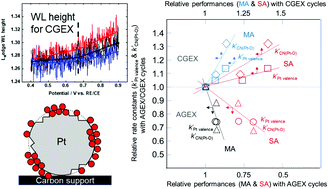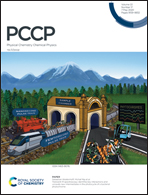Feed gas exchange (startup/shutdown) effects on Pt/C cathode electrocatalysis and surface Pt-oxide behavior in polymer electrolyte fuel cells as revealed using in situ real-time XAFS and high-resolution STEM measurements†
Abstract
The synchronizing measurements of both cyclic voltammograms (CVs) and real-time quick XAFSs (QXAFSs) for Pt/C cathode electrocatalysts in a membrane electrode assembly (MEA) of polymer electrolyte fuel cells (PEFCs) treated by anode-gas exchange (AGEX) and cathode-gas exchange (CGEX) cycles (startup/shutdown conditions of FC vehicles) were performed for the first time to understand the opposite effects of the AGEX and CGEX treatments on the Pt/C performance and durability and also the contradiction between the electrochemical active surface area (ECSA) decrease and the performance increase by CGEX treatment. While the AGEX treatment decreased both the ECSA and performance of MEA Pt/C due to carbon corrosion, it was found that the CGEX treatment decreased the ECSA but increased the Pt/C performance significantly due to high-index (331) facet formation (high-resolution STEM) and hence the suppression of strongly bound Pt-oxide formation at cathode Pt nanoparticle surfaces. Transient QXAFS time-profile analysis for the MEA Pt/C also revealed a direct relationship between the electrochemical performance or durability and transient kinetics of the Pt/C cathode.



 Please wait while we load your content...
Please wait while we load your content...